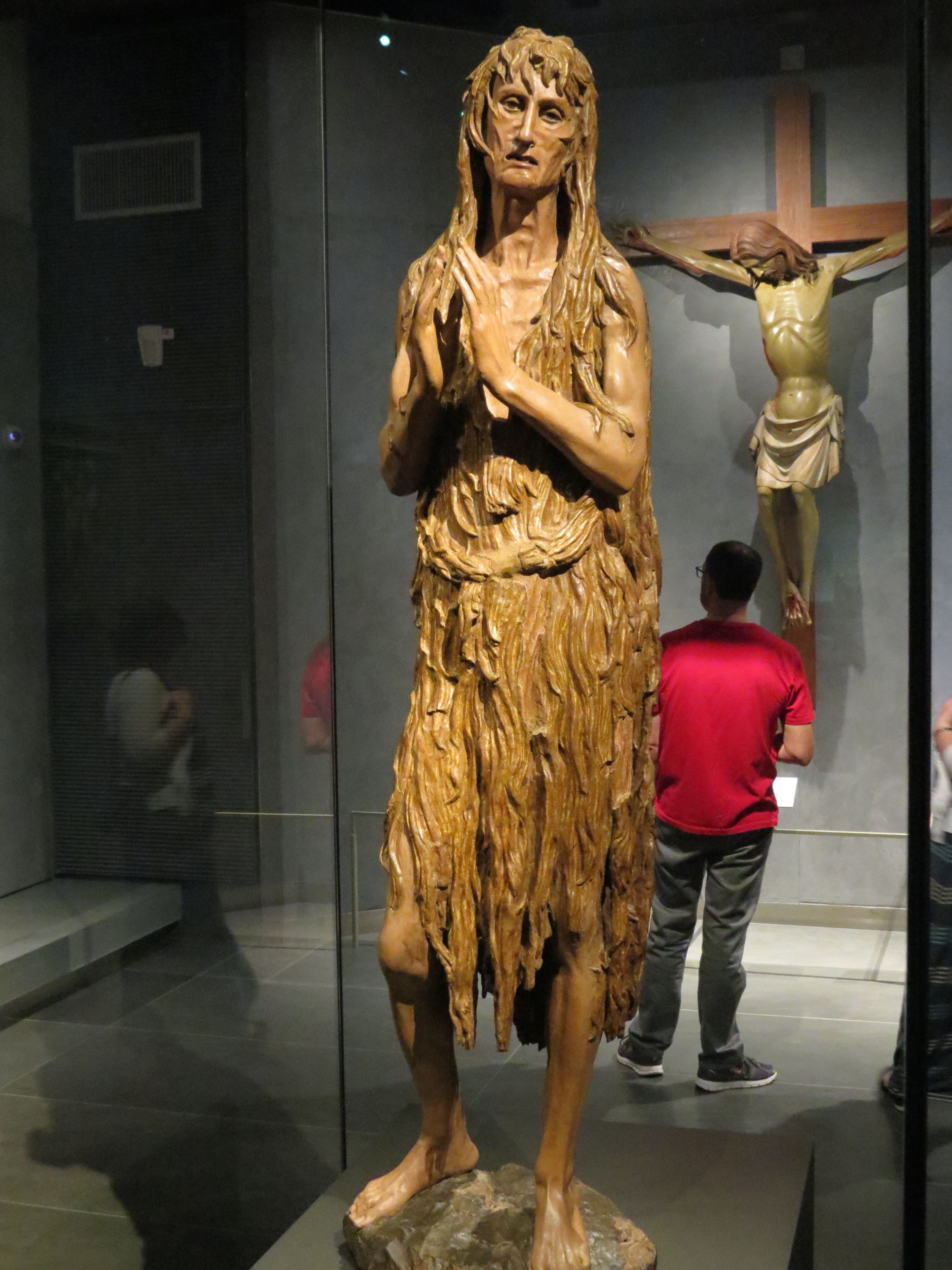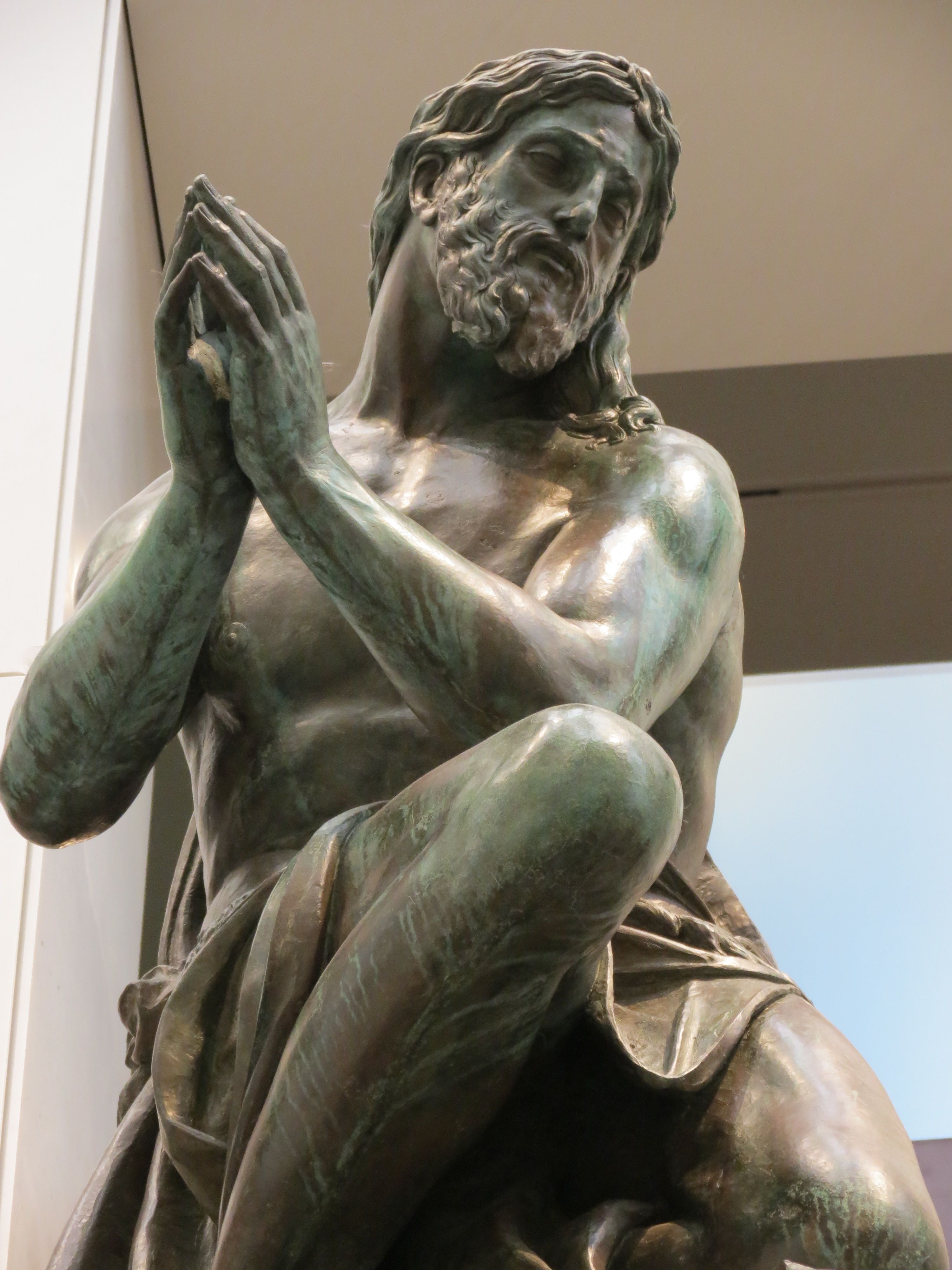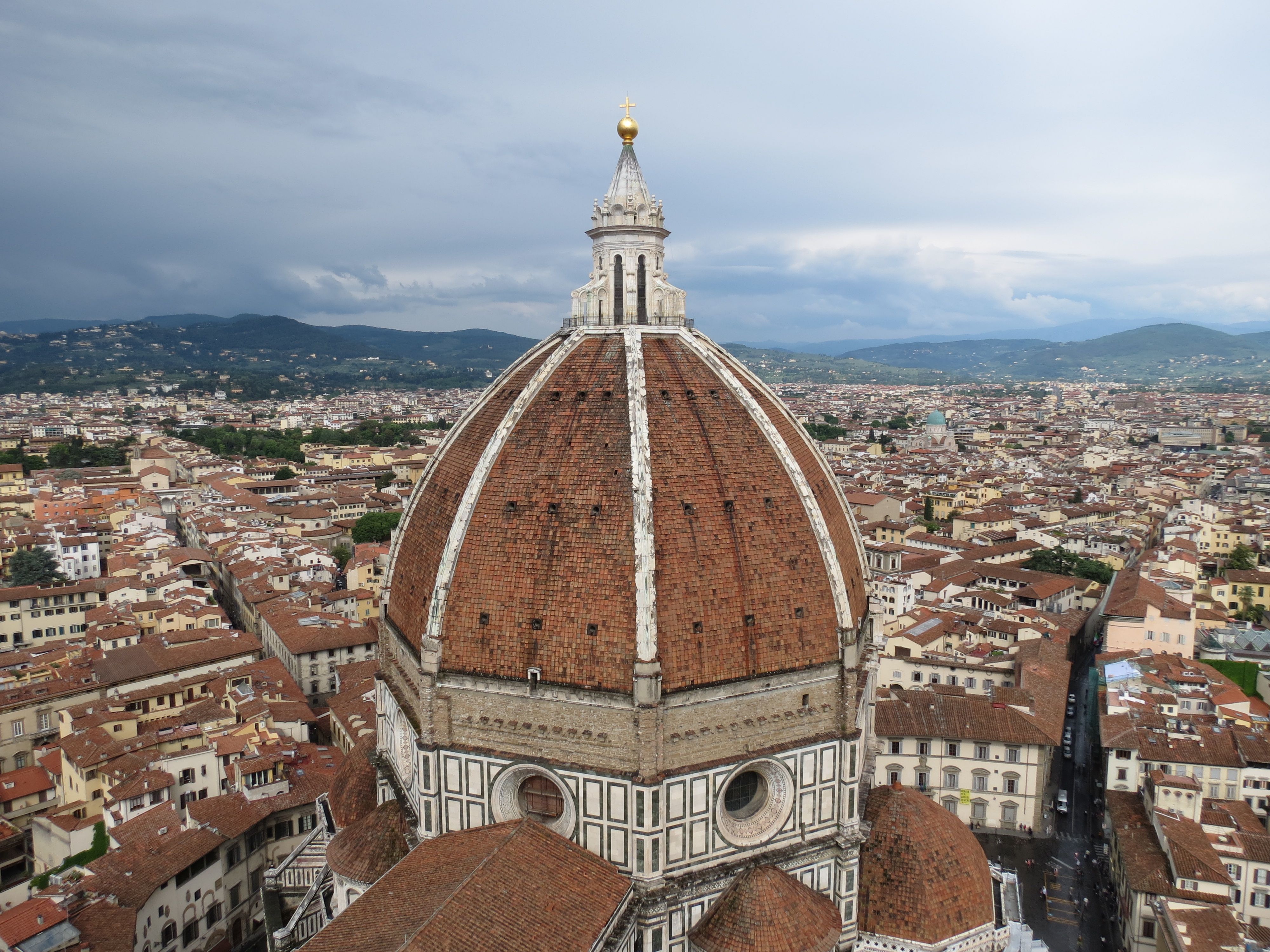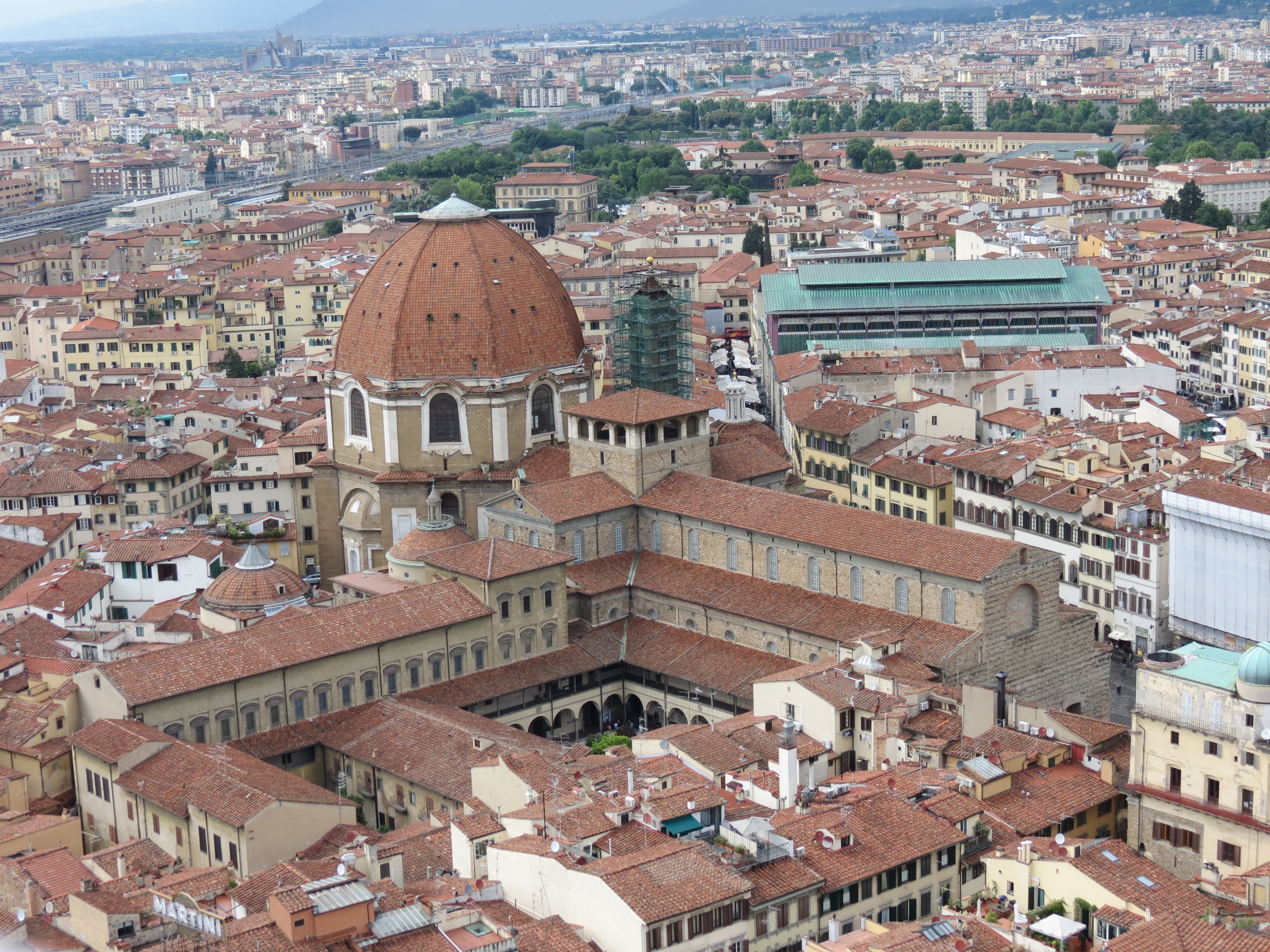You are here: Italy 2016 blog --> May 8
Previously: May 7: Firenze
May 8: Firenze
Today was “stroll around and do museums” day. Also Mother’s Day, so happy etc. to all mothers reading this!
The Firenze Mother’s Day marathon was just finishing as we started out, so we had to wait a few minutes before there was a gap large enough for us to dart cross the runners’ path. While we waited in the piazza in front of the Duomo, the Firenze “Bandieri di Uffizi” marching band was warming up in full Renaissance garb to welcome them. By the time the marathoners had passed through the piazza and begun their return, the band members were flinging their flagstaffs a good 30 feet into the air in celebration and catching them as they came down. No casualties that we noticed.
Our first stop was the (nearly) 1000-year-old Baptistry, across the street from the Duomo. This octagonal building is largely empty; the main point of interest is the huge dome, divided into eight panels that run from the walls that support the dome to the skylight at its peak. The imagery is dominated by a large circular image of Jesus, with his right thumb pointing up (above an image of souls being saved) and his left thumb pointing down (above an image of sinners being consigned to Hell). Here’s the overview, plus the medieval notion of Hell:


The illustrations are generally gorgeous, but hard on the neck because they’re so high up. Since there were several rows of benches and chairs going unused, I suggested we take turn lying on our backs (head in the other person’s lap) across the chairs rather than wrecking our necks craning upwards. Worked like a charm, but amazingly, nobody copied our example. Ah, humanity.
Next stop was the Museo di Duomo, on the far side of the Duomo. This is where some of the most impressive sculptures in Firenze can be found, as well as much good-quality art. My favorites were generally those by Donatello, and particularly the “repentent Mary Magdalene”, who reminded me a lot of Meryl Streep, and John the Baptist, about to be beheaded:


The biggest problem I had with the Museo was that of cumulative overload by the increasingly pointed examples of wretched excess. The amount of money spent on this art, and particularly the gilded and silvered speciments, could have been used to save or enrich thousands of lives. Instead, it’s paralyzed wealth, incapable of doing much other than entertaining (wealthy) tourists. I have serious issues with this whole concept that I won’t go into here.
To my enormous amusement, the medieval Christians developed an unfortunate symbology for the Duomo complex (and presumably other church complexes). They call the area between the Baptistry, where one is baptized, and the Duomo, where one receives the eucharist for the first time, “paradiso” (paradise) because of the joy one is supposed to feel between the two events. Apparently a very short-lived paradise here on Earth.
One note for Museo-goers: the museum takes the rule against bringing backpacks into the museum far more seriously than the folks at Erculaneo. I actually saw one female guard sprint across the room to nab a woman with a backpack and direct her back to the baggage check. Shoshanna and I had discussed leaving our backpacks at the hotel, and in retrospect, it was a good thing we did. I don’t expect security at the checked baggage room is particularly great.
One of the science geek joys of the Museo is their explanation of the construction of the dome of the Duomo, which was apparently completed more than a century before Brunelleschi came along and figured out how to create a dome that would span the 43-m gap in the roof: the original designers just assumed that someone would eventually solve the problem. Brunelleschi did this by borrowing a solution based on the structure of an eggshell, which is difficult to crush because of how it distributes force. Nonetheless, an amazing feat of engineering given that Brunelleschi didn’t have access to the technique of finite-element analysis or powerful computers to simulate the design. Yes, the domed structure works great for an egg, but will it support its own weight if made from stone? Apparently, yes. Amazing.
Lunch was at the “birreria” Fermente, which had really good looking whole-grain sourdough pizzas. But we’d had pizza yesterday, and wanted something more pasta-ish. So I had ricotta ravioli smothered with savory cinghiale (boar) stew and Shoshanna had “gnochetti” (gnochi with ham), both excellent. Washed down with a fruity and honeyed artisinal beer, Viaemilai.
Back to the hotel for a quick afternoon nap, then we wandered down to the Mercato Nuovo (new market), which is a tightly clustered series of tiny stalls (each about 8 feet long and 3 or 4 feet wide). There’s all kinds of tacky tourist tat, but the main attraction is endless racks of leather goods, “sold by Iranians, produced from South American leather, and manufactured in Italy” (according to Rick Steeves, famous travel show guru). Since each stall sells pretty much identical products, it leads me to wonder whether they’re all minimum-wage employees of a single company that dominates the entire tourist market. If not, they at least all seem to buy from the same factory.
Our last stop of the day was a climb up the Campanile, the bell tower beside the Duomo. We arrived towards the end of the day, just as it started raining, but got inside in short order. (Apparently, end of day is the best time to visit because lines are shortest.) Mostly there’s not much to see inside, though there are four or so viewing platforms at various heights. Sadly, to get the spectacular views of the city, you need to climb 412 stairs. (Cue my Indian Jones phrase: “Stairs. Why’d it have to be stairs?”)
Fortunately, our week of stair (and mountain) climbing in the Amalfi peninsula had toughened us, so we made it to the top in short order. We reached the level right below the bells just as someone decided it was a good time to ring them. We stood there for more than a minute, deafened by the bells. (We didn’t linger there on the way down.)
From the roof of the Campanile, you can look to every horizon. You can’t look in any direction without seeing a church or palace or other ancient structure. The views are beautiful and well worth the climb if your legs are up to it. Here are a few typical views, including a great view of the Duomo and eastern hills and one of San Lorenzo church, just around the corner from our hotel:


Dinner was at Trattoria Antellesi, just two doors from the hotel, and was lovely. I had pasta soup with fagioli (beans) blended into the broth and Shoshanna had fried polenta with a cream sauce and mushrooms, both quite lovely. For our main courses, I had firm but tender swordfish heaped with zucchini, eggplant, and red pepper, and Shoshanna had ricotta ravioli in cream sauce with zucchini, carrot, and other vegetables. Free aperatifs too at the end of dinner. (Not sure whether it was grappa with lemon, or just an unusually strong limoncello blend. Either way, yummy.)
Early-ish to bed, since tomorrow's our last full day in Italy.
May 9: Last day in Firenze
©2004–2024 Geoffrey Hart. All rights reserved.





